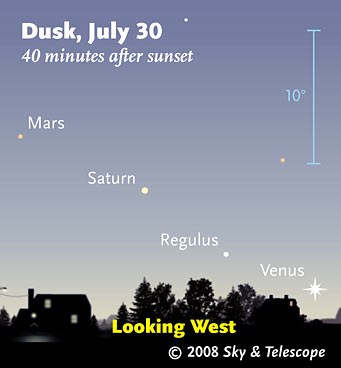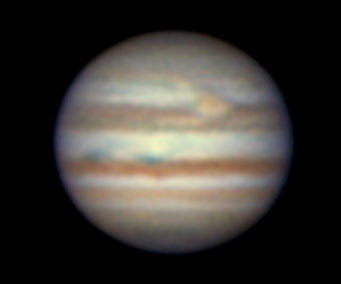Some daily events in the changing sky for July 25 – August 2.
If you're in Europe or Asia, get ready for the eclipse of the Sun coming up August 1st! See the date below. Or watch the eclipse live on the web; see our article with links.
-------------------

As July draws to its end, Mars, Saturn, Regulus, and Venus form a lineup that's almost evenly spaced. (The blue 10° scale is about the size of your fist held at arm's length.)
Sky & Telescope diagram
Friday, July 25
Saturday, July 26
Sunday, July 27
For more about observing Jupiter's moons, and a listing of all events happening among them in July (good worldwide), see the July Sky & Telescope, page 62.
Monday, July 28
Tuesday, July 29
Wednesday, July 30
Thursday, July 31
Friday, August 1
Saturday, August 2
Want to become a better amateur astronomer? Learn your way around the constellations. They're the key to locating everything fainter and deeper to hunt with binoculars or a telescope. For an easy-to-use constellation guide covering the whole evening sky, use the big monthly foldout map in each issue of Sky & Telescope, the essential magazine of astronomy. Or download our free Getting Started in Astronomy booklet (which only has bimonthly maps).
Once you get a telescope, to put it to good use you'll need a detailed, large-scale sky atlas (set of maps; the standards are Sky Atlas 2000.0 or the smaller Pocket Sky Atlas) and good deep-sky guidebooks (such as Sky Atlas 2000.0 Companion by Strong and Sinnott, the even more detailed Night Sky Observer's Guide by Kepple and Sanner, or the classic Burnham's Celestial Handbook). Read how to use them effectively.
More beginners' tips: "How to Start Right in Astronomy".
This Week's Planet Roundup
Mercury is hidden in the glare of the Sun. Next week, however, it will emerge from the sunset to begin fine configurations with Venus, Saturn, and Regulus.
Venus (magnitude –3.9) is still deep in the glow of sunset. Using binoculars, look for it just above the west-northwest horizon 20 to 40 minutes after sundown, as shown at the top of this page. Try also for much fainter Regulus nearby. Venus is slowly making its way up toward a grand "Evening Star" showing in late fall and winter.
Mars and Saturn (magnitudes +1.7 and +0.8) are getting farther apart and sliding lower toward Venus in the evening twilight, as shown at the top of this page.

Jupiter's Great Red Spot (GRS) and, to its upper left, Oval BA ("Red Spot Junior") were approaching the planet's central meridian when Sean Walker took this image at 2:16 UT July 27th through mediocre seeing. South is up, to match the view in many telescopes.
In recent weeks Oval BA passed by the GRS unscathed, but the newer red marking named the "Little Red Spot" got pulled into the GRS and disappeared.
S&T: Sean Walker
Jupiter (magnitude –2.7, in Sagittarius) shines with a steady glare in the southeast to south during evening. It's left of the Sagittarius Teapot and just below the bowl of the smaller, dimmer Teaspoon. It's highest by around 11 p.m. daylight saving time. For high-resolution scopes in excellent seeing, Jupiter's Great Red Spot and its little red companions put on an interesting performance in the last few weeks; see press release from the Hubble Space Telescope site.
Uranus and Neptune (magnitudes 5.8 and 7.8, respectively, in Aquarius and Capricornus) are well up in the southeast by midnight. Use our article and finder charts.
Pluto (magnitude 14.0, in the northwestern corner of Sagittarius) is highest in the south in late evening. If you've got a big scope and a dark sky, use our article and finder chart.
All descriptions that relate to your horizon or zenith — including the words up, down, right, and left — are written for the world's mid-northern latitudes. Descriptions that also depend on longitude (mainly Moon positions) are for North America. Eastern Daylight Time (EDT) equals Universal Time (UT, UTC, or GMT) minus 4 hours.
----------------------
To be sure to get the current Sky at a Glance, bookmark this URL:
http://SkyandTelescope.com/observing/ataglance?1=1
If pictures fail to load, refresh the page. If they still fail to load, change the 1 at the end of this URL to any other character and try again.
 0
0
Comments
You must be logged in to post a comment.